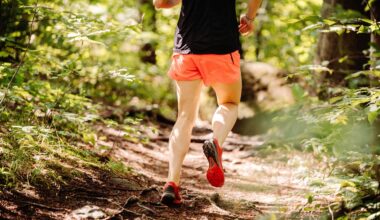Advanced Plyometric Warm-up Techniques for Pros
Plyometric warm-up routines are essential for athletes seeking to enhance their performance and prevent injuries during intense physical activities. These routines help to prepare the body by increasing heart rate, boosting blood flow to muscles, and improving joint mobility. Dynamic stretches combined with plyometric exercises can optimize an athlete’s readiness for explosiveness. For instance, including exercises like high knees, butt kicks, and lateral shuffles can engage the muscles effectively. During plyometric warm-ups, it’s vital to focus on proper form to maximize benefits and reduce risk factors. Athletes should gradually progress in complexity and intensity to ensure a comprehensive approach to their warm-up techniques. This leads to effective muscle activation, helping muscle fibers to fire up properly before explosive activities commence. Emphasizing a combination of strength, mobility, and flexibility exercises will help build a balanced warm-up routine. Coaches and trainers might also recommend personalized routines based on individual needs and skill levels. Integrating plyometric techniques not only prepares the body but can also enhance overall athletic performance significantly. Adopting such warm-up strategies ensures athletes are primed and aligned mentally and physically for peak performance in their respective sports.
The significance of proper warm-up cannot be understated, particularly for athletes involved in high-intensity training and competitions. Plyometric drills have the potential to amplify muscle elasticity, making the muscles more responsive to explosive movements. This increased response rate is crucial as it can lead to improved jump height, sprint speed, and overall agility. Incorporating multi-directional movements within the warm-up is effective, allowing for muscles to adapt to various athletic demands. For instance, box jumps, depth jumps, and bounding exercises can be interspersed with dynamic stretching to activate different muscle groups thoroughly. Additionally, these exercises stimulate the nervous system effectively, preparing it for anticipated reactions required during performance. Plyometric warm-ups should include a variety of movements targeting the core, legs, and upper body since a collaborative effort from all major muscle groups yields better results. Sufficient emphasis should be placed on agility drills that compel the athlete to switch directions rapidly. Ultimately, creating a balanced plyometric routine that engages all major muscle groups can significantly elevate an athlete’s competitive edge while minimizing injury risks through systematic conditioning.
Key Plyometric Warm-up Exercises
Understanding which specific exercises to integrate into plyometric warm-ups is key to achieving optimal results. Exercises such as the tuck jump, where the knees are lifted towards the chest in a jumping motion, help enhance explosive power. Another effective drill is the lateral bound, fostering balance and lateral stability by practicing side-to-side jumps. Additionally, the power skip combines strength and agility, pushing athletes to leap forward while maintaining proper form. Toe taps are ideal for improving foot speed, focusing on quick transitions between ground contact and lifting the feet. Performing these drills in sequence can overwhelm the muscles positively, driving adaptations in both speed and power. Gradual progression in difficulty is crucial; starting with simpler movements before gradually incorporating more complex maneuvers can promote safety and effectiveness. Flexibility can also be improved through appropriate stretching within the warm-up. Using targeting techniques allows athletes to feel empowered and invigorated prior to performances or rigorous trainings. Thus, choosing suitable plyometric exercises optimizes the athlete’s performance while ensuring sickness does not hinder growth.
Structuring the Warm-up Routine
Structuring a plyometric warm-up routine effectively encompasses multiple components all aimed towards enhancing athletic performance. To begin, a general warm-up phase with light aerobic activities such as jogging or cycling can elevate the heart rate while increasing blood flow and muscle temperature. Following this, dynamic stretching should occur; highlighting movements that imitate sports-specific skills ensures that muscles are fully engaged. Athletes can then transition into plyometric drills that escalate in intensity, promoting muscle elastic reserves. Keeping the duration of the warm-up between 15 to 30 minutes often yields the best results, with subsequent rest intervals to ensure maximum performance during the routine. Attention to fluid transitions between exercises maintains momentum and keeps the athlete engaged and focused. Throughout this structure, monitoring the individual’s response to exercises allows for necessary adjustments to be made. Incorporating feedback aids in individualizing the warm-up, promoting both accountability and commitment. Thus, creating an organized and tailored warm-up routine can lead to better results and recovery. Ultimately, this diligence can foster the athlete’s overall growth and longevity in their respective sports.
Nutritional considerations can also play a significant role in an athlete’s readiness for plyometric training. Before initiating a plyometric warm-up, athletes may choose to consume a light snack rich in carbohydrates to fuel the body. Proper hydration is equally crucial; athletes should ensure they are consuming adequate fluids to support performance during training sessions. Balancing fluid intake with electrolyte replenishment aids in maintaining vigor throughout intense exercises. Post-warm-up nutrition is focused on protein-rich snacks; these should facilitate muscle recovery as athletes engage in endurance-demanding workouts following their routines. Understanding these nutritional aspects aligns physical preparation with dietary support to encourage overall performance. Furthermore, employing electrolytes and vitamins specifically tailored to an athlete’s needs can enhance their performance positively. Coaches must educate athletes on time management between meals and workouts, stressing how it impacts energy levels while influencing muscle recovery. Integrating these nutritional tips alongside established warm-up routines benefits athletes beyond the physical realm. Therefore, as crucial as physical training is, proper nutrition complements an athlete’s preparation significantly, supporting endurance and strength for peak athletic performance.
Monitoring Progress and Adjustments
Consistent monitoring during plyometric warm-ups helps athletes track their progress effectively. Keeping a training log allows them to reflect on areas of improvement, both in skills achieved and physical readiness. Recording metrics like jump height, agility drills, and fatigue levels can inform necessary adjustments to any routines. If athletes show signs of excessive fatigue or diminished performance, it may be time to modify routines accordingly. Progressive overload can be employed to increase workout intensity; this technique encourages gradual advancements over time. Additionally, cycling through various drills prevents physical plateaus and keeps training sessions fresh and engaging. Coaches can help by offering feedback and assessing performance, ensuring athletes are reaching their peak potential without over-exerting themselves. Setting short and long-term goals alongside monitoring provides sufficient motivation as athletes evaluate their performance against targets established. Ultimately, the blend of structured progress assessment with personalized feedback will empower athletes to make informed decisions about their plyometric training. Adapting to individual monitoring results sustains interest and nurtures continuous improvement in athletic capabilities.
In conclusion, advanced plyometric warm-up techniques set the stage for outstanding athletic performance while reducing injury risks. Implementing a combination of dynamic stretching, multi-directional plyometric exercises, and thoughtfully structured routines enhances muscle responsiveness. It’s essential to focus on comprehensive engagement across muscle groups including the core, legs, and upper body. Monitoring nutritional intake assists in aligning physical performance with dietary needs while maintaining appropriate hydration levels. Furthermore, each individualized program should remain adaptable to ongoing assessment, promoting growth and peak performance. Athletes who embrace these innovative warm-up strategies not only prepare their bodies physically but also cultivate mental resilience. Successful athletes combine hard work, proper nutrition, and tailored warm-up regimens to push their limits. Factors such as fatigue levels and specific muscle readiness should guide adjustments in their routines. A commitment to understanding each element of preparation enhances performance while minimizing injury risks. The continuous pursuit of excellence on the part of athletes translates into both their athletic and personal growth. Hence, integrating advanced plyometric warm-up routines lays a solid foundation for success in any sport.
A focus on progressive adaptation ensures the refinement and longevity of athletic abilities. It is crucial that each athlete personalizes their approach, making necessary adjustments to suit their unique physical attributes, experiences, and goals. Continuous education about plyometric techniques, exercises, and proper warm-up strategies can empower athletes in their training journey. Ultimately, the integration of science and skill will bolster performance consistently with breakthroughs in each training phase. Seeking professional guidance, where available, can further accelerate progress through tailored coaching. Equipping athletes with effective warm-up knowledge fortifies their foundation for athletic excellence. Thus, advanced plyometric warm-up techniques are not merely a routine; they embody an athlete’s commitment to their sport, consistency, perseverance, and unwavering dedication.


